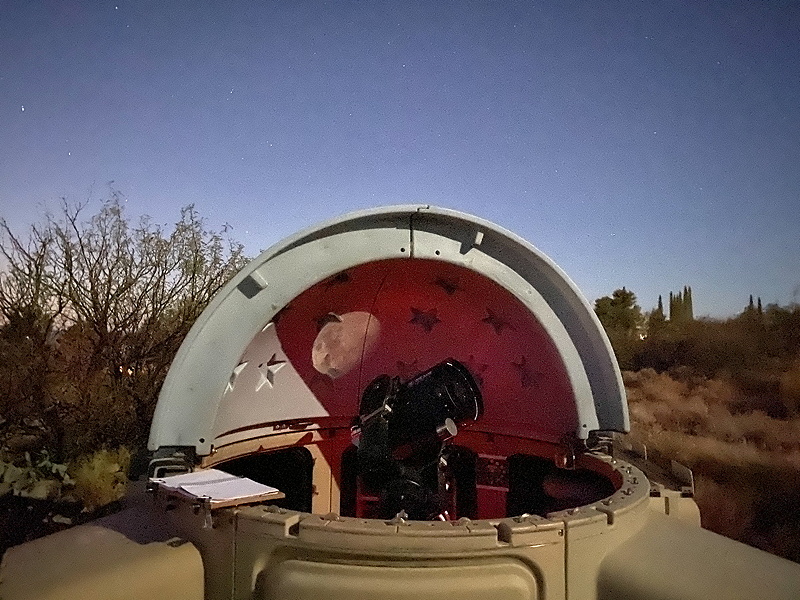iPhone: Moon on SkyShed POD Dome
Posted: 28 October 2020
Friday, 23 October 2020, began clear but clouds from an approaching storm system arrived late afternoon. Saturday, 24 October, and Sunday, 25 October, were cloudy. Haven't had clouds like these in a long time, but the clouds made for nice sunsets. These photos were captured by a webcam facing West.


The temperature dropped dramatically as a cold front approached and I was finally able to stop running the air conditioner in the observatory during the daytime. Had some rain (0.06") on Monday, 26 October, which was our first rain since a light shower in early August 2020. Tuesday morning, 27 October, had some snow flurries with the temperature 37°F. Summer weather may be finally over. Cloudy skies continued until Tuesday late afternoonn when the sky cleared. However, as sunset approached, a narrow band of clouds came down from the North right over Oracle. I decided to go out anyway for a short time.
|
Open: Tuesday, 27 October 2020, 1815 MST Temperature: 52°F |
Session: 1546 Conditions: Partly cloudy |
Equipment:
12" f/8 LX600 w/StarLock
2" 24mm UWA eyepiece
Camera:
iPhone 11 Pro Max
This is that cloud band as it appeared in the southern portion of the sky. Jupiter is the bright dot near the center of the photograph. Taken with the iPhone 11 Pro Max Camera app (Night Mode, 3 seconds, 1X lens), handheld.

1819 MST: LX600 ON, StarLock OFF, High Precision OFF.
Viewed the waxing gibbous Moon, 102X.
Handheld the iPhone over the 2" 24mm UWA eyepiece for this afocal 102X image taken with the NightCap Camera app (ISO 32, 1/340sec, 1X lens).

I stepped outside of the observatory and took this handheld iPhone 11 Pro Max photo of the Moon projected onto the SkyShed POD dome from the Meade 12" telescope. The double star Mizar in the handle of the Big Dipper is at the upper left edge of the photo. The photo was taken using the Camera app (Night Mode, 3 seconds, 1X lens).

I then observed Jupiter and the four Galilean Moons and Saturn and three moons, 102X, through thin clouds.
1835 MST: viewed Mars, 102X. The view was not very good as Mars was still low in the eastern sky and there were some thin clouds. It also began getting breezy.
Next, viewed Saturn and Jupiter, 12x50 binoculars. The planets were not quite in the same 4.6° field-of-view of the binoculars this night but will be getting closer together each night on the way to their very close conjunction (0.1°) on 21 December 2020.
Viewed the Moon, then Mars, 12x50 binoculars. Mars still showed a disk in the 12X-power binoculars.
1841 MST: LX600 OFF.
|
Close: Tuesday, 27 October 2020, 1847 MST Temperature: 46°F |
Session Length: 0h 32m Conditions: Mostly clear, breezy |
Comments are welcome using Email. Twitter users can use the button below to tweet this report to their followers. Thanks.
Cassiopeia Observatory Home Page
Copyright ©2020 Michael L. Weasner / mweasner@me.com
URL = http://www.weasner.com/co/Reports/2020/10/28/index.html
